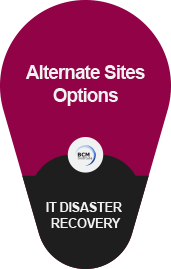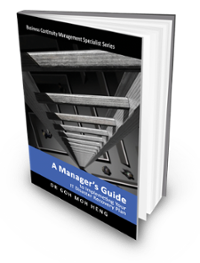Alternate Sites Options
Alternate sites or facility are required as part of DR strategy to enable recovery and operation during a prolonged disaster situation. Although major disruptions with long-term effects may be rare, they should be accounted for in the DR Plan. In general, there are two main types of options for alternate sites available for consideration:
- Dedicated Site
- Reciprocal Site
Also, there are two terminologies that are used:
- Primary site
- A site whereby the main IT infrastructure is located.
- Backup of Secondary site
An alternate or backup site to be used during a disruption or disaster
Dedicated Site
Dedicated site is owned or operated by the organization is a very costly option as it has to invest in building and maintaining an alternate site that is fully equipped with all the necessary power, telecommunications, security mechanisms and hardware that are required to perform as a fully operational site just like the main office, in case the main office is rendered un-operational should a disaster strike.
Reciprocal Site
The reciprocal site is to have a reciprocal agreement or memorandum of agreement with an internal or external entity. This agreement allows two organizations to back each other up. It is also sometimes referred to as a mutual-aid agreement.
Reciprocal sites can be drawn up between two similarly configured organizations. Each organization must have spare processing time, hardware capability or amenity at a limited capacity to support the critical business functions and applications of the organization in distress. These arrangements are usually used by large companies with many subsidiaries. Even in these cases, it is rare that enough spare processing time and equipment capability exist to support a mutual recovery arrangement.
When you are negotiating a reciprocal site, there is a need to be extra cautious to review that each site must be capable of supporting the other. This is in addition to its own existing workload and schedule, especially in the event of a disaster. This type of agreement requires the recovery sequence for the applications from both organizations to be prioritized with a joint perspective.
Reference
Goh, M. H. (2016). A Manager's Guide to Implementing Your IT Disaster Recovery Plan. Business Continuity Management Specialist Series (2nd ed.). Singapore: GMH Pte Ltd.
Extracted from "Chapter 10: DR Strategy: Alternate Sites"
More Information About IT DR Blended Learning
To know more about our blended learning program and when the next course is scheduled, feel free to contact our friendly course consultant colleagues via sales.ap@bcm-institute.org.
They are the BL-DR-3 Blended Learning DR-300 IT Disaster Recovery Implementer and the BL-DR-5 Blended Learning DR-5000 IT Disaster Recovery Expert Implementer.
 |
 |
 |
![[BL-DR-5] DRP-5000 Course Schedule 2020](https://blog.bcm-institute.org/hs-fs/hubfs/hub_generated/resized/16932a89-e3f4-4b43-8b11-27d3f71e2eb2.png?width=200&height=59&name=16932a89-e3f4-4b43-8b11-27d3f71e2eb2.png) |
 |
![[BL-DR-5] DRP-5000 Register Now](https://blog.bcm-institute.org/hs-fs/hubfs/hub_generated/resized/f68e3f39-f42c-47d2-8140-f19a4b9701d4.png?width=200&height=59&name=f68e3f39-f42c-47d2-8140-f19a4b9701d4.png) |
 |
Please feel free to send us a note if you have any of these questions to sales.ap@bcm-institute.org |
 |



